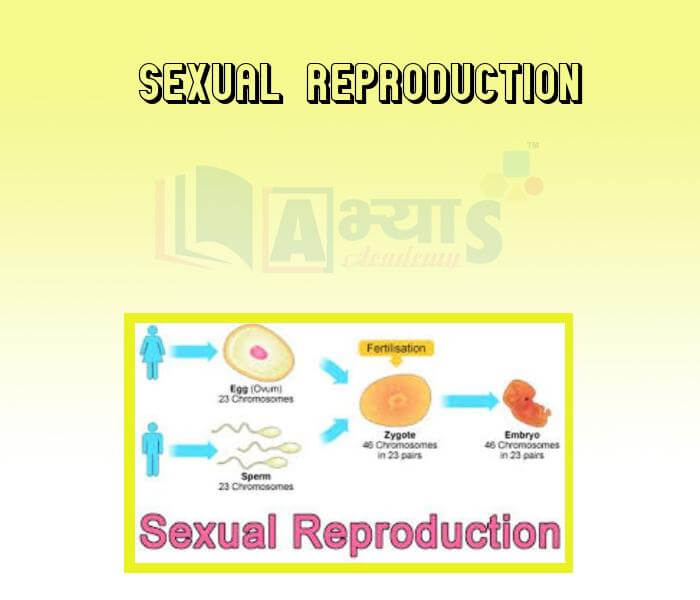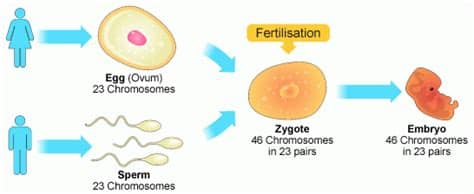Sexual Reproduction













Sexual Reproduction
Sexual reproduction involves the two sexes, namely, male and female. The male sexual unit is known as male gamete or sperm, while the female sexual unit is known as female gamete or egg. The formation of gametes and their fusion constitute sexual reproduction. The male gamete is smaller and more active than the female gamete. The female gamete is larger, filled with reserve food and remains passive. The cell formed after the fusion of the male and female gametes is called zygote. The zygote divides repeatedly to form a new individual. Although sexual reproduction also occurs in unicellular organisms like algae and Paramoecium, it is most common in multicellular organisms.

Genetic basis and advantage of variations: You know that variations help in the survival of a species over time. During asexual reproduction cells divide and DNA replication takes place. At the time of replication, some variation may occur but this variation does not usually cause any drastic change. So, in asexual reproduction offspring are more or less similar to the parent and variation is slow. During sexual reproduction two types of gametes (male and female) are formed. During the fusion of gametes there is recombination of genetic material from two parents. This leads to greater variation in the offspring. As the offspring gets more variations, it is more likely to adjust better to environmental fluctuations.
Gametes contain half the usual number of chromosomes: During sexual reproduction, the combination of DNA from two parents would result in the offspring having twice the amount of DNA. To solve this problem, sexually reproducing individuals have special germ cells (gametes) with only half the normal number of chromosomes and, therefore, half the amount of DNA compared to the other cells of the body. When such germ cells from two individuals unite during sexual reproduction, the normal chromosome number and DNA content are restored.
Significance of sexual reproduction: Sexual reproduction results in new combinations of genes that are brought together during gamete formation. This reshuffling of genes in the gametes increases the chances of variation in the offspring. Moreover, the combination of two sets of chromosomes, one set from each parent, during zygote formation, leads to variation within a species.

Sexual Reproduction : - This mode of reproduction involves the union of male and female. The fusion of gametes result in the formation of zygote fro which the new individual develops. This process is termed as fertilisation. So fertilisation is the fusion of the nuclei of male and female gamete to form a zygote from which a new individual can develop.
In animals, the male and female gametes are generally produced in separate individuals. The male gamete is called the sperm and is produced in the testes. The female gamete is called the ovum or egg and is produced in the ovaries. In certain animals like the tapeworm both sex organs (testes and ovary) are present in a single individual.
In plants, the sexes may or may not be separated. Accordingly, a flower is either unisexual (bearing either male or female game or bisexual (bearing both gametes).
Characteristics of sexual reproduction
Sometimes, larvae develop gonads and reproduce by normal sexual reproduction. It is called ____________________ | |||
| Right Option : B | |||
| View Explanation | |||
Human has _______ mode of reproduction | |||
| Right Option : A | |||
| View Explanation | |||
Characters transmitted from parents to offspring are present in ____________________ | |||
| Right Option : D | |||
| View Explanation | |||
Students / Parents Reviews [10]
My experience with Abhyas is very good. I have learnt many things here like vedic maths and reasoning also. Teachers here first take our doubts and then there are assignments to verify our weak points.

Shivam Rana
7thAbout Abhyas metholodology the teachers are very nice and hardworking toward students.The Centre Head Mrs Anu Sethi is also a brilliant teacher.Abhyas has taught me how to overcome problems and has always taken my doubts and suppoeted me.

Shreya Shrivastava
8thIt has a great methodology. Students here can get analysis to their test quickly.We can learn easily through PPTs and the testing methods are good. We know that where we have to practice

Barkha Arora
10thAbhyas Methodology is very good. It is based on according to student and each child manages accordingly to its properly. Methodology has improved the abilities of students to shine them in future.

Manish Kumar
10thIt was a good experience with Abhyas Academy. I even faced problems in starting but slowly and steadily overcomed. Especially reasoning classes helped me a lot.

Cheshta
10thMy experience was very good with Abhyas academy. I am studying here from 6th class and I am satisfied by its results in my life. I improved a lot here ahead of school syllabus.

Ayan Ghosh
8thBeing a parent, I saw my daughter improvement in her studies by seeing a good result in all day to day compititive exam TMO, NSO, IEO etc and as well as studies. I have got a fruitful result from my daughter.

Prisha Gupta
8thA marvelous experience with Abhyas. I am glad to share that my ward has achieved more than enough at the Ambala ABHYAS centre. Years have passed on and more and more he has gained. May the centre flourish and develop day by day by the grace of God.

Archit Segal
7thMy experience with Abhyas academy is very good. I did not think that my every subject coming here will be so strong. The main thing is that the online tests had made me learn here more things.

Hiya Gupta
8thI have spent a wonderful time in Abhyas academy. It has made my reasoning more apt, English more stronger and Maths an interesting subject for me. It has given me a habbit of self studying
